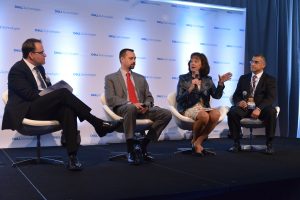The conversation on digital transformation in government is building and we’re excited to hear it and add to the noise. We value the thoughtful exchange of ideas and exploration of issues — it’s one of the traits that keeps Dell EMC innovative.

At the recent Dell Technologies Digital Transformation Summit in Washington, D.C., we brought together leaders from industry and the federal technology community to discuss how agencies can take action now to make digital transformation a reality. There were many great conversations, but I’d like to highlight four key takeaways from government IT leaders at the event.
Workforce Transformation —Tapping New Talent and Technologies to Enable Mission Accomplishment
Just like any business, government depends on the talent of its workforce to thrive. Several panelists focused on the need to attract more great minds, particularly millennials, into federal government service. It’s acknowledged that federal pay and perks are not what millennials could command in the private sector. To compete, government has to offer something more. Federal service, if powered by the right technology, appeals to millennials’ sense of mission, desire to tackle big challenges and determination to help a greater cause, whether that’s providing aid following a natural disaster or helping America win in the cyber war. Technology enables this, making information easily accessible on mobile devices, supporting quick data analysis and more, so employees can quickly make informed decisions and take action.
Technology can also elevate roles across the workforce. Andrew Hallman, head of the CIA Digital Innovation Directorate, looked at how artificial intelligence (AI) and machine learning would revolutionize the agency’s intelligence-gathering capabilities, in turn eliminating some of the more time-consuming tasks of intelligence analysts’ jobs. Instead, analysts can now focus their attention on deriving actionable insights from the data.
IT Transformation…Ongoing Process, Not One-time Event
Summit participants continued to urge federal agencies to take their own IT transformation journey. Washington, D.C. Chief Technology Officer Archana Vemulapalli contributed an insightful perspective on this process.

Vemulapalli recognized digital transformation is an ongoing process that is sustained over time, but said too many government agencies consider it a single event. Other types of infrastructure, like our transportation systems, are built with an understanding that ongoing, regular maintenance is a given and that roadways will need to scale to changing population needs. As Vemulapalli noted, roads are built, fixed and repaved regularly. In contrast, IT systems are acquired, installed and operated, and 15 years or more may pass before they are replaced. While the gaps left by aging IT systems are different from potholes in the road, the consequences can be much more damaging, creating cybersecurity gaps that could leave citizens’ personal information or even national security at risk. Government leaders recognize this challenge and are ready to take action.
Security Transformation—Public and Private Sectors Need to Join Forces
This leads us to one issue that can’t be ignored in any federal IT discussion – cybersecurity. Grant Schneider, acting CISO and senior director, National Security Council, focused on cybersecurity from a unique angle, namely, service provider expectations and the technologies that underpin federal cybersecurity strategy.
A key takeaway? Effective cybersecurity requires a public-private partnership. Schneider added a perspective on how private companies can provide the best value to government in the partnership. He looks for five things from service providers. First, technology must be simple. He added that tools must be agile enough to solve next week’s issue, but still capable of integrating seamlessly with existing tools. Schneider also stressed the need for affordable solutions. Finally, he said that securing systems is essential, but they must also be easy to use. Employees bypassing security controls is too common as they seek to get work done. The integration of security platforms must be seamless.
Making Transformation a Reality—It Requires Discipline
Another common thread throughout the discussion was the recognition that the technology agencies need in most cases is there, but that culturally agencies are being held back. Speakers offered solutions to drive action from this perspective as well.
Great ideas can be simple and obvious. And so is Army Chief Data Officer Thomas Sasala’s common-sense approach to transformation. He noted the key to making things happen starts with discipline. Once a decision to shut down a legacy system is made, it must be executed. For the Army, he added, the big test is how to keep critical systems operating while also upgrading IT.
It’s essential to hear from IT leaders on the front lines of agencies’ digital transformation efforts. They inspire us and can help us map out the right solution to accomplish mission needs. As their trusted advisors, we are determined to support their critical work. At Dell EMC, we’re committed to empowering these outstanding public servants to lead their agencies to success.
Were you able to join us at the Dell Technologies Digital Transformation Summit? Let us know what you took away from the event.